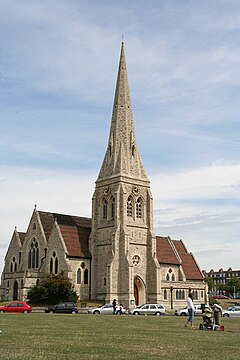Blackheath, London
Blackheath is a heathland area of South East London. Formerly in Kent, it is now shared between the London Boroughs of Lewisham and Greenwich. Blackheath has one of the largest areas of common land in Greater London.[1]

History change
The name is recorded in 1166 as Blachehedfeld and means the "dark coloured heathland".[2] It is formed from the Old English 'blæc' and 'hǣth' and refers to the open space that was the meeting place of the ancient hundred of Blackheath.[2] The name was later used for the Victorian suburb that developed in the 19th century and was extended to the areas known as Blackheath Park and Blackheath Vale.[2]
Origins change
The Roman road that later became known as Watling Street crosses the northern edge of Blackheath (almost in line with the A2).
Blackheath was a rallying point for Wat Tyler's Peasants' Revolt of 1381, and for Jack Cade's Kentish rebellion in 1450. Wat Tyler is remembered by Wat Tyler Road on the heath. After pitching camp on Blackheath, Cornish rebels were defeated in the Battle of Deptford Bridge (sometimes called the Battle of Blackheath), just to the west, on 17 June 1497.
With Watling Street carrying stagecoaches across the heath, on the way to north Kent and the Channel ports, it was also a common place for highwaymen to rob travelers during the 17th and 18th centuries.
Blackheath Park change
The sizeable estate of Blackheath Park was created on lands of Wricklemarsh Manor, and built over in the late 18th and early 19th centuries. It has fine examples of substantial Georgian and Victorian houses – most notably Michael Searles' crescent of semi-detached terrace houses linked by colonnades, The Paragon (c 1793-1807).[3]
The Pagoda is a good example of a beautiful property in Blackheath, built in 1760 by Sir William Chambers. It was later leased to the Prince Regent, who later became King George IV, and used as a summer home by his wife Caroline, Princess of Wales.
Sports change
In 1608, according to tradition, Blackheath was the place where golf was introduced to England – the Royal Blackheath Golf Club.[4] The club was one of the first golf associations established (1766) outside Scotland. Since 1923 it has been in nearby Eltham. Blackheath also gave its name to the first hockey club, established during the mid 19th century.
The Blackheath Rugby Club was founded in 1858, the oldest rugby club in England. The Blackheath club organised the world's first rugby international (between England and Scotland in Edinburgh on 27 March 1871), and hosted the first international between England and Wales ten years later. Blackheath Rugby Club was one of the 12 founding members of the Football Association in 1863.
References change
- ↑ "Common Land and the Commons Act 2006". Defra. 13 November 2012. Retrieved 3 February 2013.
- ↑ 2.0 2.1 2.2 Mills A.D. (2010). Dictionary of London place names. Oxford. ISBN 978-0199566785.
- ↑ Howard Colvin, Biographical Dictionary of British Architects, 1600-1840, 3rd ed. 1995, s.v. "Searles, Michael".
- ↑ "Our history: Royal Blackheath Golf Club – the oldest golf club in the world". Royalblackheath.com. Retrieved 29 August 2011.
